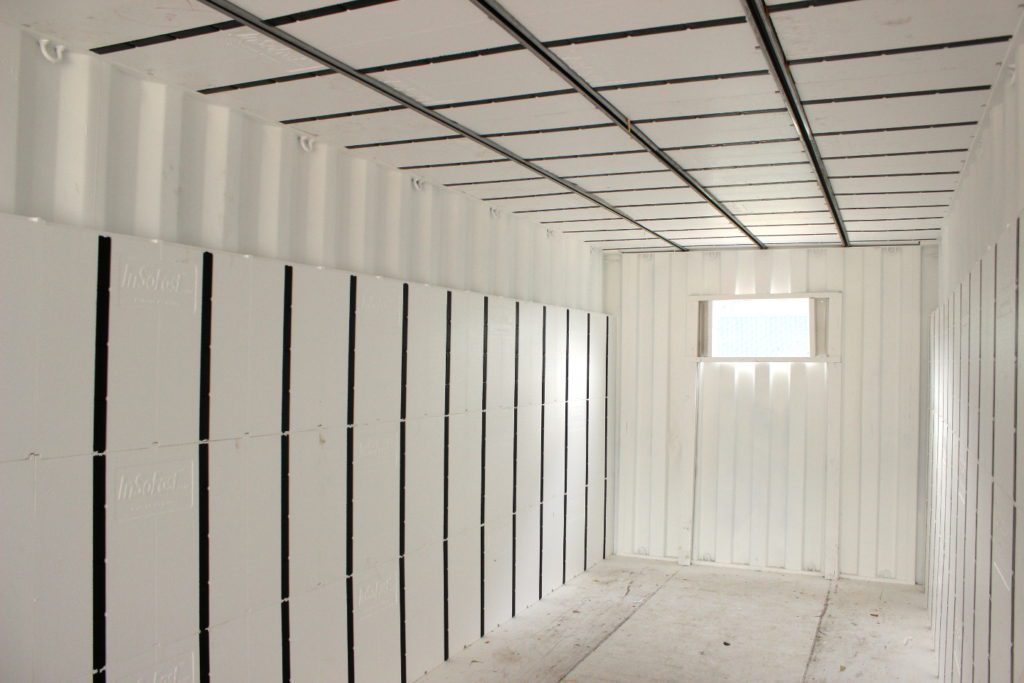A successful shipping container transformation into an office, home, worship center, pop-up shop, or other useful structure will depend on quality, effective insulation. While there are many products to choose from for shipping container insulation, buy InSoFast panels if you value convenience, effectiveness, and versatility for your Montana container project.
Potential Insulation Choices
The right insulation for your shipping container project should work with your budget, your location, and the metal composition of the shipping container.

Unconventional Insulation Methods
Eco-friendly warriors and budget-limited hobbyists will often choose unconventional options for insulation. These methods suffer from a lower R-value and may not be a lifetime solution for those planning on building a real home. Some of these non-traditional methods include newspaper lining, stacking straw bales around the container’s exterior, and using blocks made from hemp called hempcrete.
Blanket/Roll Insulation
This type of insulation comes in rolls or pre-cut wall lengths. Applying this type of insulation works by installing it within the wall cavity between the studs. While this variety of insulation is the most affordable and one of the easiest to install, thermal bridges will occur at the stud locations because of the break in insulation coverage. Blanket insulation may be fiberglass, wool, and cotton.
The trouble with this type of insulation relates to water. Condensation and vapor are significant issues with metal containers because of the conductivity of the structure, and when the insulation gets wet, it will be a less effective insulator, encourage the development of mold and mildew, and hasten the decay of the entire structure.
Loose-Fill Insulation Products
Loose-fill insulation also goes within the wall cavity, filling it completely and requiring a wooden frame structure. This type of insulation can be cellulose, fiberglass, vermiculite, or perlite.
Loose-fill insulation is often not recommended for shipping container applications because of its permeability.
Sprayed Insulation
Insulation that’s sprayed as a liquid that later hardens is an effective way to insulate difficult to reach areas. This insulation can be problematic in that it requires professional installation and can make quite a mess.
Sprayed insulation can be open-cell polyurethane foam and closed-cell polyurethane foam. Closed-cell has a higher R-value and is recommended for shipping containers over open-cell spray insulation.
Expanded Foam Insulation Panels
Insulation panels don’t require a wooden frame because they’re applied directly to the container wall, and they’re modifiable to fit elements of construction like outlets, windows, and doors. Some of these panels can see a reduction in R-value over time, but this problem does not apply to InSoFast insulation products.
These products are largely project suitable and easily applied. Some of these products, including InSoFast shipping container panels, are designed to fit tightly against container walls. These products largely work as systems of continuous insulation coverage. As with spray foam insulation, these panels can be open and closed cell insulation, with closed-cell offering higher R-values.
InSoFast Insulation Products
With our products, you get convenient application, high R-values, a tight fit, chemical and physical stability, a built-in non-conductive frame, and more reasons to choose them as the most practical and long-lasting insulation product.
Choices include the following:
- InSoFast CX 44 Shipping Container Panels
- InSoFast InSerts for End Walls, Side Walls, and Ceilings paired with UX 2.0 or EXi 2.5 panels
- InSoFast CX-LP Low-Pro Embedded Studs used with InSerts and generic rigid foam board
If you’re ready to build a shipping container out into a new structure in Montana, buy InSoFast shipping container insulation panels for assured success that’s affordable and fast. Dial (888) 396-9677 for more information today!


